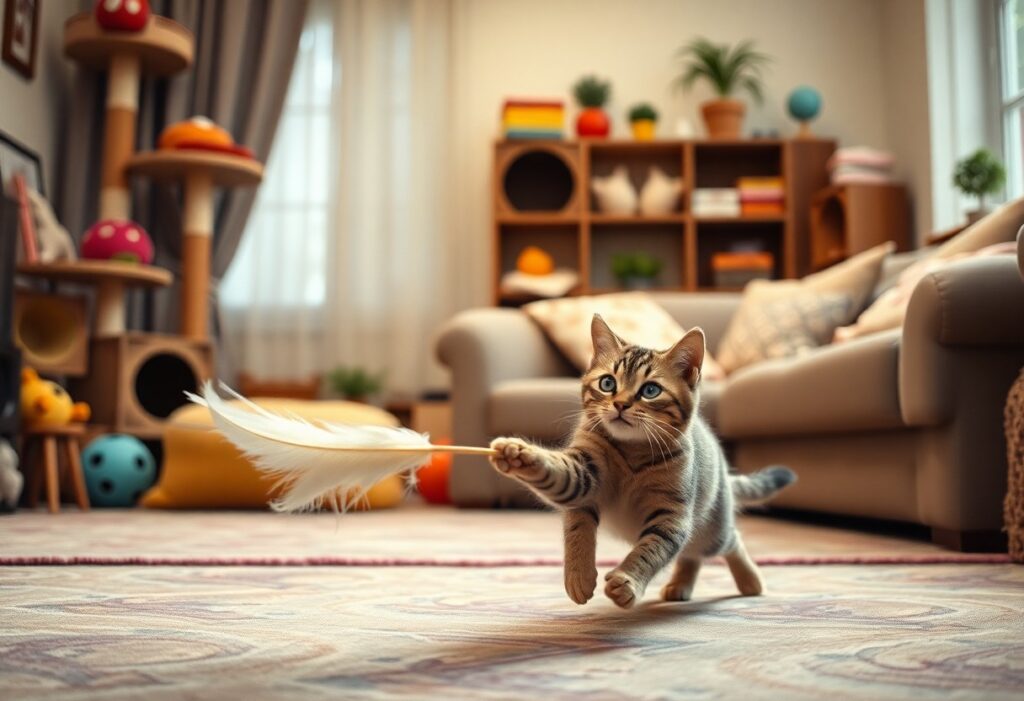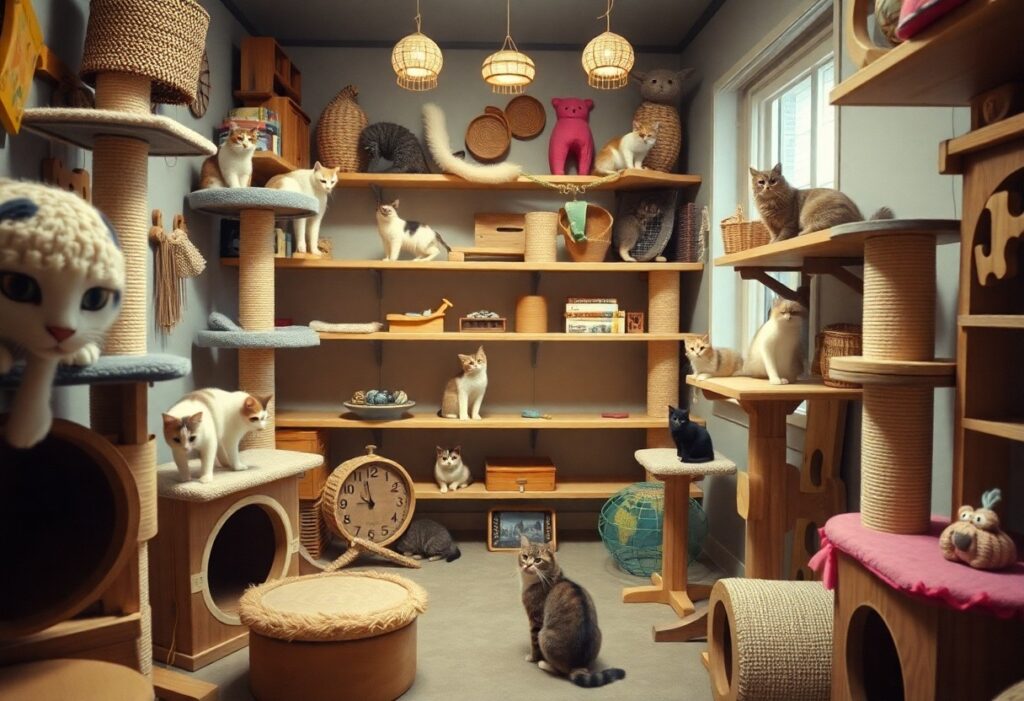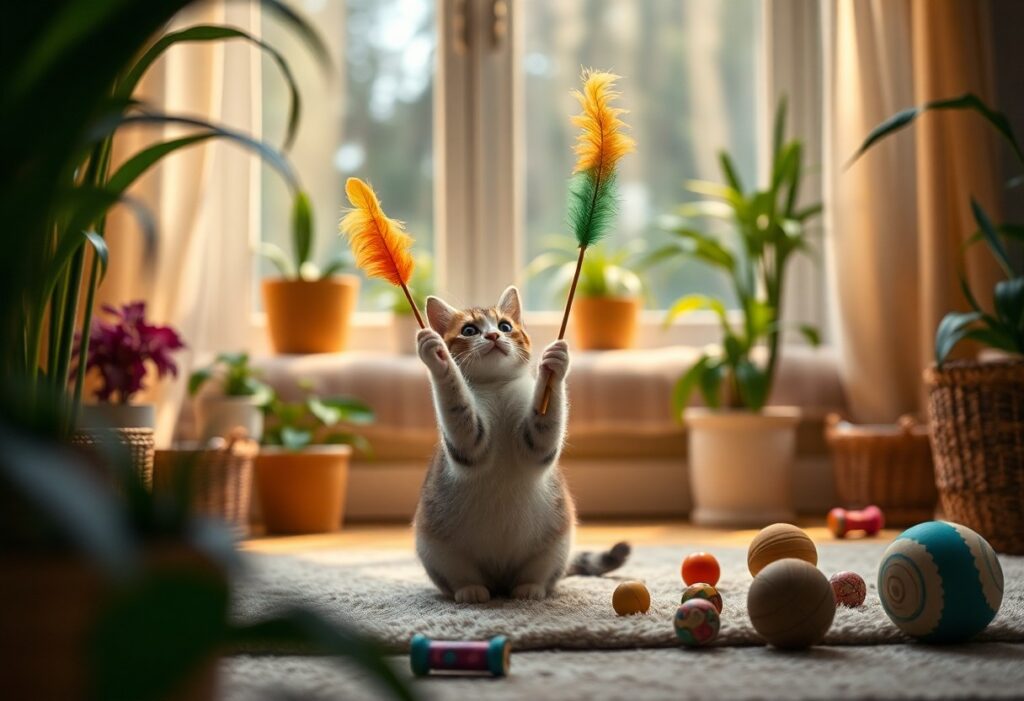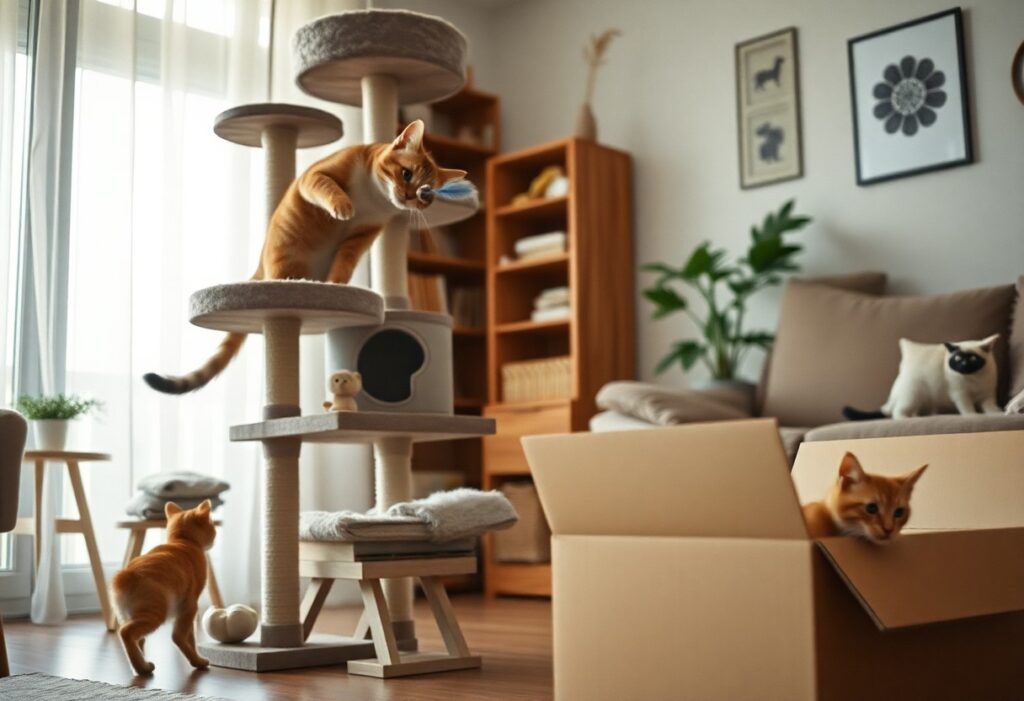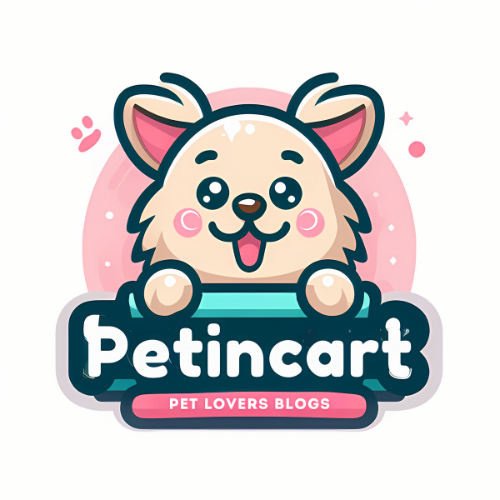Get ready to unleash your cat’s playful energy indoors with engaging activities that stimulate their mind and body! If you want to keep your feline friend happy and healthy, it’s crucial to provide them with exciting interactions and challenges. This guide will help you discover a variety of fun and safe ways to enrich your cat’s environment, turning your home into a play paradise. From DIY toys to interactive games, you’ll find methods to connect with your pet and ensure they lead a fulfilling life even when stuck inside!
Key Takeaways:
- Provide a variety of toys such as feathers, balls, and puzzle feeders to stimulate your cat’s natural hunting instincts and keep them entertained.
- Incorporate interactive playtime using wand toys or laser pointers to strengthen the bond between you and your cat while encouraging physical activity.
- Create an engaging environment by setting up climbing structures or hiding spots, which allows your cat to explore and exercise safely indoors.
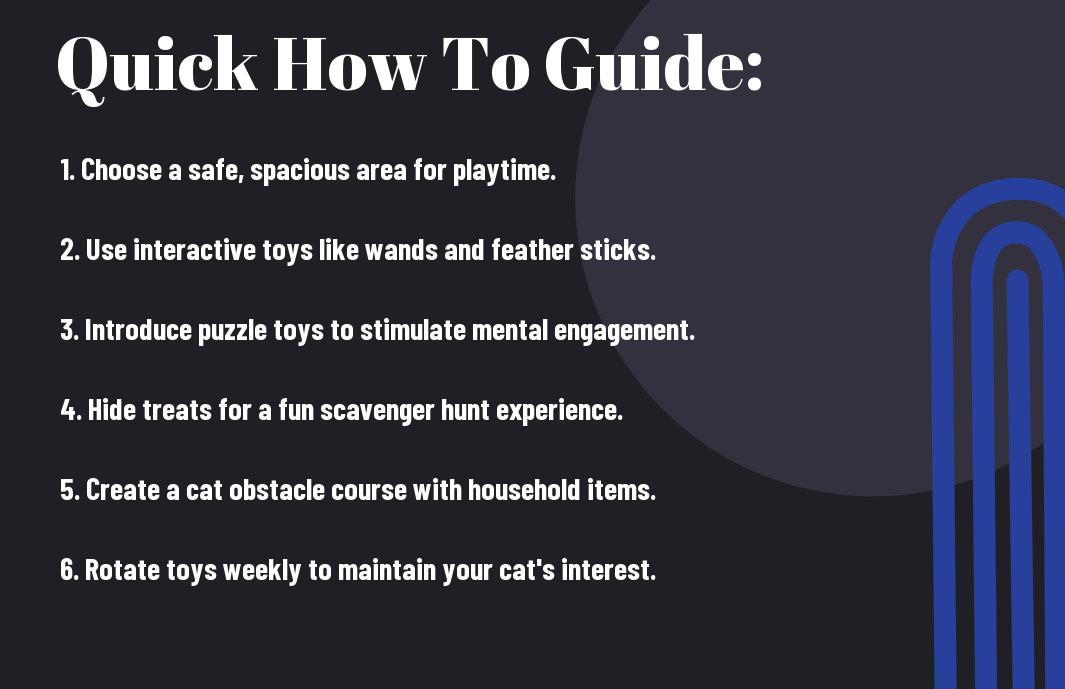
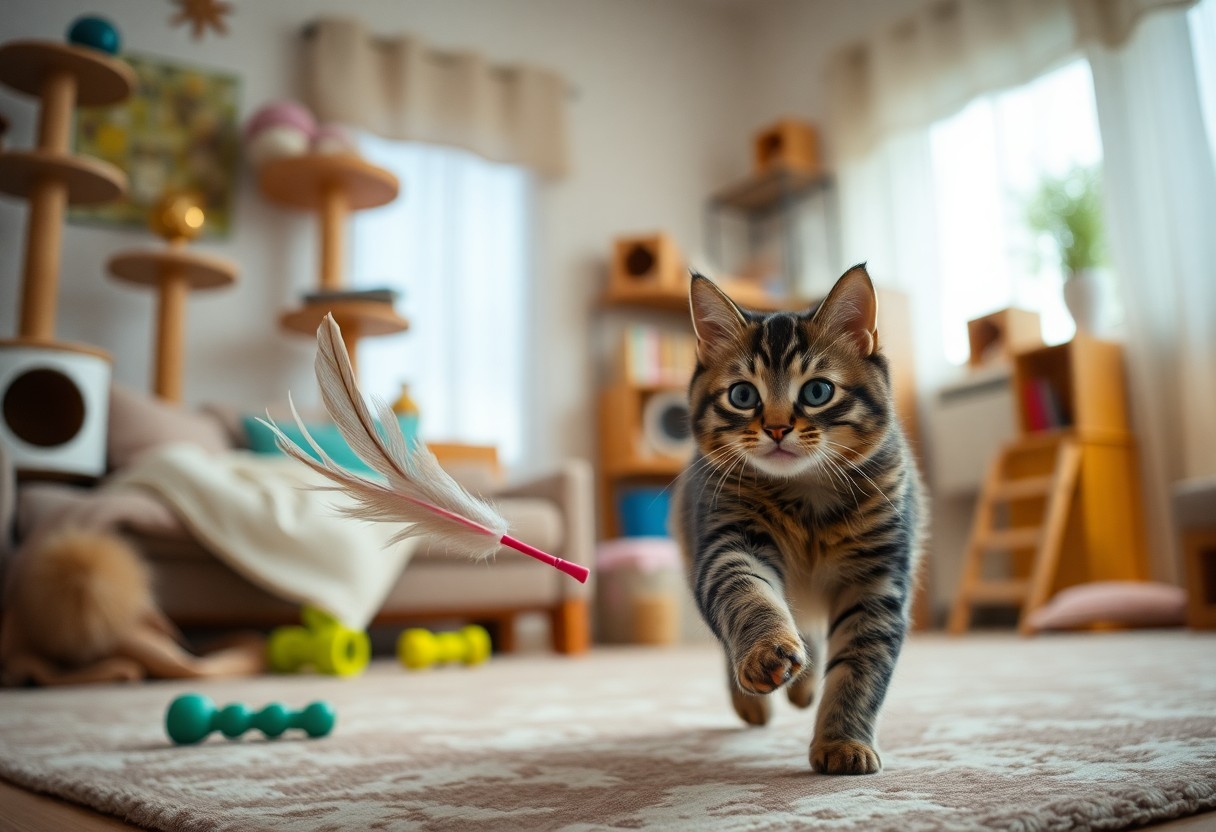
Understanding Your Cat’s Playful Nature
Before you can engage your playful cat, it’s imperative to understand their unique nature. Cats are instinctive hunters, and their playful behavior mimics the actions they would take in the wild. This playful curiosity is integral to their overall well-being and helps them bond with you. By leveraging their natural instincts, you can provide fulfilling activities that keep them both mentally and physically stimulated.
The Importance of Play for Cats
Little do many cat owners know that playing is not just a form of entertainment; it is imperative for your cat’s physical health and emotional well-being. Engaging in regular play reduces the risk of obesity, helps alleviate stress, and enriches their environment. This shared time reinforces your bond and creates a happier, healthier cat.
Recognizing Playful Behaviors
Play is an integral aspect of your cat’s daily routine, and recognizing their playful behaviors can enhance your interactions.
With keen observation, you’ll identify signs of playfulness such as pouncing, chasing, and rolling around on the floor. These behaviors indicate that your cat is ready to engage and desires mental stimulation. Look for toys that stimulate these instincts, and provide a space where they can explore and play safely. Remember to be mindful of their mood; playful behavior can quickly turn to aggression if they become overstimulated, so always monitor their responses to ensure a positive experience.
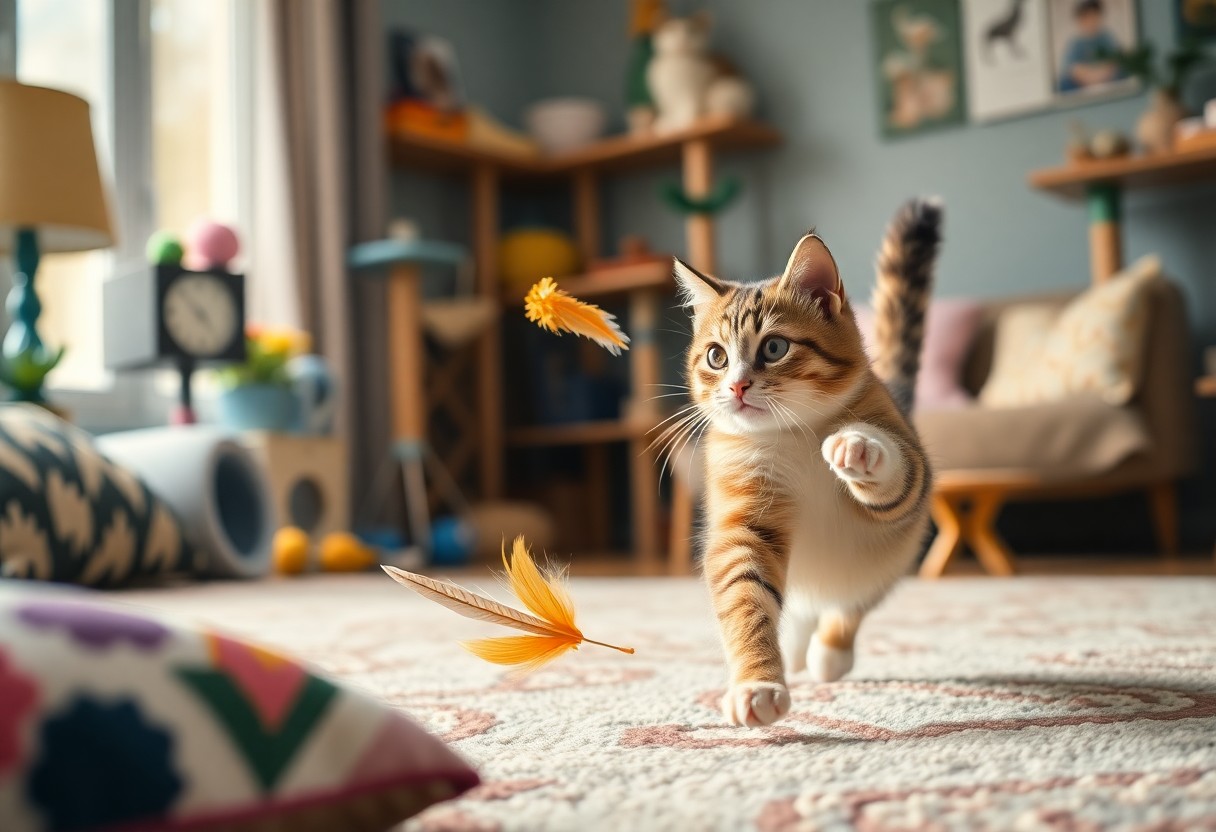
How-to Create an Engaging Indoor Environment
Assuming you want to enrich your home for your playful cat, it’s vital to design an engaging indoor space that stimulates their natural instincts. Incorporate various climbing structures, cozy hiding spots, and interactive elements to encourage exploration. Cat trees, shelves, and multi-level spaces can provide endless opportunities for your feline to play and observe their surroundings, ensuring their environment is both fun and safe.
Tips for Cat-Friendly Spaces
Any cat owner should prioritize creating a safe and appealing environment for their furry friend. Consider these tips:
- Incorporate vertical spaces for climbing and perching.
- Provide cozy hiding spots where your cat can retreat.
- Use soft, non-toxic materials for all items.
- Ensure there are ample opportunities for interactive play.
The end result will be a supportive environment for your cat to thrive.
Factors to Consider When Choosing Indoor Toys
The selection of toys for your cat should align with their unique personality and behavior. Consider the following factors:
- Choose toys that mimic hunting behaviors.
- Look for durable materials that can withstand rough play.
- Ensure toys are the appropriate size and shape for your cat.
- Opt for items that include interactive features for engagement.
Recognizing the needs of your cat will guide you in making the best choices.
Environment matters significantly when choosing toys for your cat. Opt for items that mimic their natural hunting instincts, such as feather wands or laser pointers, to keep them engaged. Selecting the right size and shape helps prevent choking hazards, while durable materials ensure the toys can withstand energetic playtime. Additionally, interactive toys, like puzzle feeders, stimulate your cat’s mental health. Recognizing these vital factors will enhance your cat’s overall play experience.

Fun Indoor Activities for Your Cat
Many cats thrive indoors with the right stimulation. Engaging activities can reduce boredom, encourage exercise, and strengthen your bond with your playful feline. Incorporate a variety of interactive games and creative DIY projects to keep your cat entertained and satisfied during their indoor adventures.
Interactive Games to Try
Games like feather wands, laser pointers, and puzzle toys capture your cat’s attention while promoting physical activity. These interactive games not only ignite their hunting instincts but also provide mental challenges that keep them entertained for hours. Regularly rotating different toys will maintain their interest and enthusiasm.
DIY Toys and Activities
One of the easiest ways to engage your cat is by creating DIY toys and activities using household items. Simple cardboard boxes, toilet paper rolls, and old socks can be transformed into exciting new playthings that stimulate your cat’s curiosity.
Activities such as filling a cardboard tube with treats or crafting sock balls can provide endless fun. Just ensure that any materials you use are non-toxic and safe for your pet, as some items might pose a choking hazard. Regularly monitor your DIY toys for wear and tear, and replace them if they become a safety concern. Your cat will appreciate your creativity, and you will enjoy watching them engage with these homemade treasures!
How to Use Technology to Engage Your Cat
Despite being a species that thrives on physical interaction, your cat can benefit from modern technology to keep boredom at bay. Utilizing apps and devices designed for feline entertainment allows you to engage your playful cat from anywhere in your home. From remote-operated toys to interactive screens, these tech options provide endless fun, stimulating your cat’s senses while promoting physical activity and mental agility.
Digital Play Options
There’s an abundance of digital play options available for your cat, including mobile apps and interactive toys. Many apps feature moving images of birds or fish that can captivate your feline’s attention, offering mental stimulation. You can also find laser toys or treat dispensers that can be operated through your smartphone, providing a fun way for you and your cat to play, even when you’re busy!
Monitoring Playtime Effectively
Monitoring your cat’s playtime is vital to ensure they are getting the right amount of exercise and stimulation. You can track your cat’s engagement with technology using apps that monitor their activity levels and duration of play. This helps you identify patterns and adjust play sessions accordingly to maintain a healthy balance of physical and mental activity.
With the right approach, technology can enhance your cat’s playtime experience significantly. Setting limits on screen time is important, so your cat doesn’t become overly reliant on digital entertainment. Additionally, keeping track of their enthusiasm during sessions allows you to adjust the intensity and type of play. Finally, always supervise your cat while they are engaging with technology to ensure they don’t develop any unhealthy habits related to excessive screen time.
Tips for Encouraging Physical Activity
For a playful cat, engaging in physical activity is necessary for their health and happiness. Here are some tips to encourage a more active lifestyle:
- Rotate toys to maintain interest.
- Provide vertical space to climb and explore.
- Engage in interactive play with feather wands or lasers.
- Utilize food puzzles to stimulate their minds and bodies.
Assume that engaging your cat in their playtime will strengthen your bond and enhance their overall well-being.
Short Play Sessions for Best Results
With your cat’s attention span being relatively short, conducting brief play sessions can yield better results. Aim for multiple 5–10 minute sessions throughout the day, keeping your cat excited and engaged while limiting fatigue. This approach prevents overstimulation and promotes consistent exercise.
Incorporating Stimulation into Daily Routines
The best way to ensure your cat gets enough physical activity is by incorporating stimulation into daily routines. Simple actions can make a significant difference.
Tips include integrating playtime during your morning and evening routines to engage your cat while you prepare for your day or wind down in the evening. You may also hide toys around your home, allowing your cat to actively explore and discover them. This encourages not only physical movement but also mental stimulation as they search. Always supervise your cat during play to avoid accidents and ensure that they’re in a safe environment.
Factors that Influence Your Cat’s Engagement
To create the best indoor activities for your cat, several factors can influence their engagement, including:
- Age
- Energy Levels
- Personality
- Preferences
Assume that understanding these elements will help you tailor activities that match your cat’s unique needs and interests.
Age and Energy Levels
The age of your cat significantly affects their energy levels and willingness to engage in play. Kittens are often energetic and playful, while older cats may prefer more relaxed activities. Adjusting the type and intensity of play is vital to keep your cat stimulated and happy.
Personality and Preferences
On the other hand, your cat’s personality and preferences play a key role in their engagement during playtime. Each cat has a distinct temperament ranging from curious and adventurous to shy and reserved. Understanding what excites or frightens your cat will help you choose activities they find enjoyable. You can introduce various toys and games to discover what they love most, but always ensure these options are safe and suitable for their personality type.
Personality traits can greatly shape your cat’s experiences and interactions. For instance, a bold cat may thrive on interactive games, while a more timid feline could prefer quiet, solitary play. By paying attention to your cat’s responses to different activities, you can identify their favorites and create a positive atmosphere for fun and engagement. Always prioritize providing a safe environment, reducing any fears they may have, and offering a variety of experiences to keep them entertained.
Final Words
With these considerations, you can successfully engage your playful cat through a variety of fun indoor activities. Incorporating interactive toys, puzzle feeders, and creative playtime can help keep your feline friend mentally stimulated and physically active. Tailoring these activities to your cat’s personality will not only enhance their happiness but also strengthen the bond between you. Explore different options and observe what excites your cat the most, making playtime a rewarding and enjoyable experience for both of you.
FAQ
Q: What are some engaging indoor activities for my playful cat?
A: Cats love to explore and play. Here are a few activities that can keep them entertained:
1. Interactive Toys: Puzzle feeders or toys that require them to solve a challenge to get a treat can stimulate their minds.
2. Laser Pointer Games: Use a laser pointer to have them chase and pounce; just be sure to avoid shining it in their eyes.
3. Hide and Seek: Hide behind furniture and call your cat, rewarding them with treats when they find you.
4. DIY obstacle course: Set up an agility course with boxes, tunnels, and soft materials for them to climb or crawl through.
5. Catnip Playtime: Introducing catnip-infused toys can heighten their enthusiasm and encourage active play.
Q: How can I encourage my shy cat to participate in indoor games?
A: For shy cats, it’s crucial to create a comfortable environment. Start with gentle interaction and gradually introduce new games. Here are a few tips:
1. Start Slow: Use soft, quiet toys that don’t startle them. Feather wands or soft balls can be good options.
2. Incorporate Treats: Rewarding them with treats while playing can help build their confidence.
3. Short Sessions: Keep play sessions brief and positive, gradually increasing the duration as your cat becomes more comfortable.
4. Safe Space: Create a cozy nook with their favorite blanket where they can retreat if they feel overwhelmed.
5. Positive Reinforcement: Always praise them when they engage in play to encourage continued participation.
Q: Are there specific toys that are best for indoor play with cats?
A: Yes, certain toys tend to engage cats more effectively. Here are a few noteworthy options:
1. Wand Toys: They mimic prey movement and allow for interactive play, which is great for bonding.
2. Ball Toys: Small, lightweight balls that can be batted around easily are perfect for solo play.
3. Feather Toys: Cats are often drawn to feathers, making these toys exciting for jumping and pouncing.
4. Electronic Toys: Toys that move or make sounds can catch your cat’s interest and keep them entertained.
5. Scratching Posts with Toys: Combining a scratching post with hanging toys can provide multiple forms of exercise and play.
Q: How often should I engage my cat in indoor activities?
A: Engaging your cat in playtime should be part of their daily routine. Aim for at least 15-30 minutes of active play a few times a day. Adjust the frequency based on your cat’s energy levels and interest. Younger cats may require more playtime, while older or less active cats might prefer shorter and less intensive sessions. The key is to strike a balance between active play and allowing your cat to rest, ensuring they remain happy and healthy.
Q: How can I tell if my cat is enjoying the indoor activities?
A: There are several signs that indicate your cat is enjoying their playtime:
1. Playful Behavior: They will likely exhibit signs of excitement, such as pouncing, chasing, or batting at toys vigorously.
2. Vocalizations: Happy cats may meow or chirp during play, indicating they’re engaged and having fun.
3. Body Language: An open stance, flicking tail, and playful pouncing indicate interest and enjoyment.
4. Purring: A purring cat typically shows contentment, especially when interacting with you or their toys.
5. Curiosity: If your cat actively investigates new toys or engages with them enthusiastically, it’s a good sign they are enjoying the activity.
